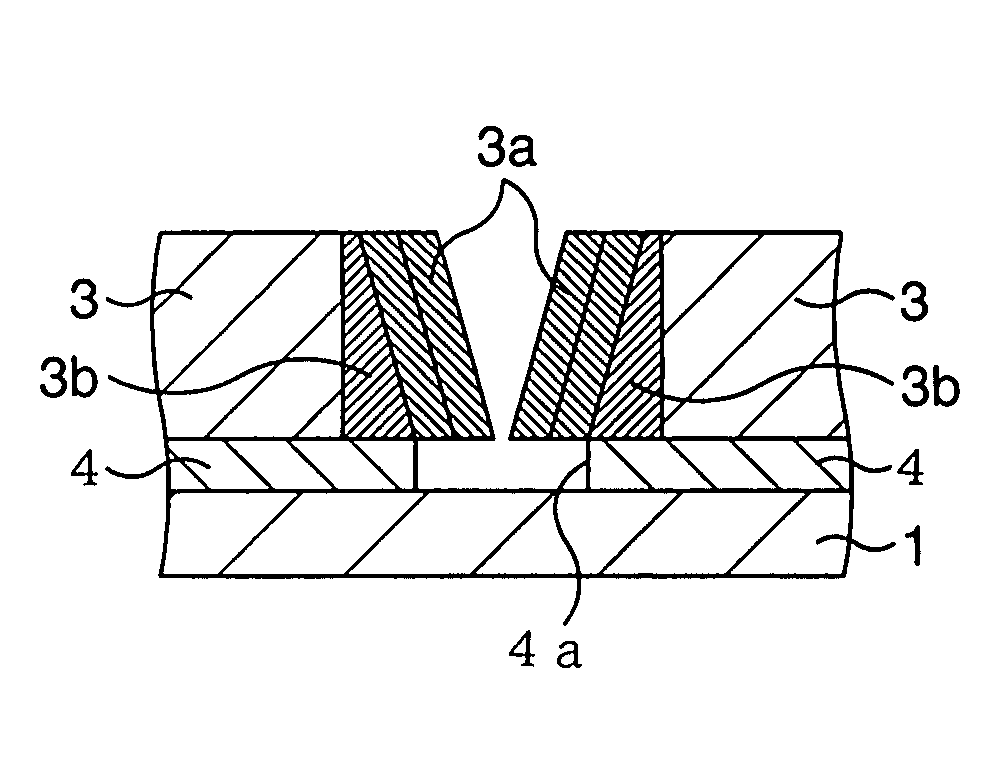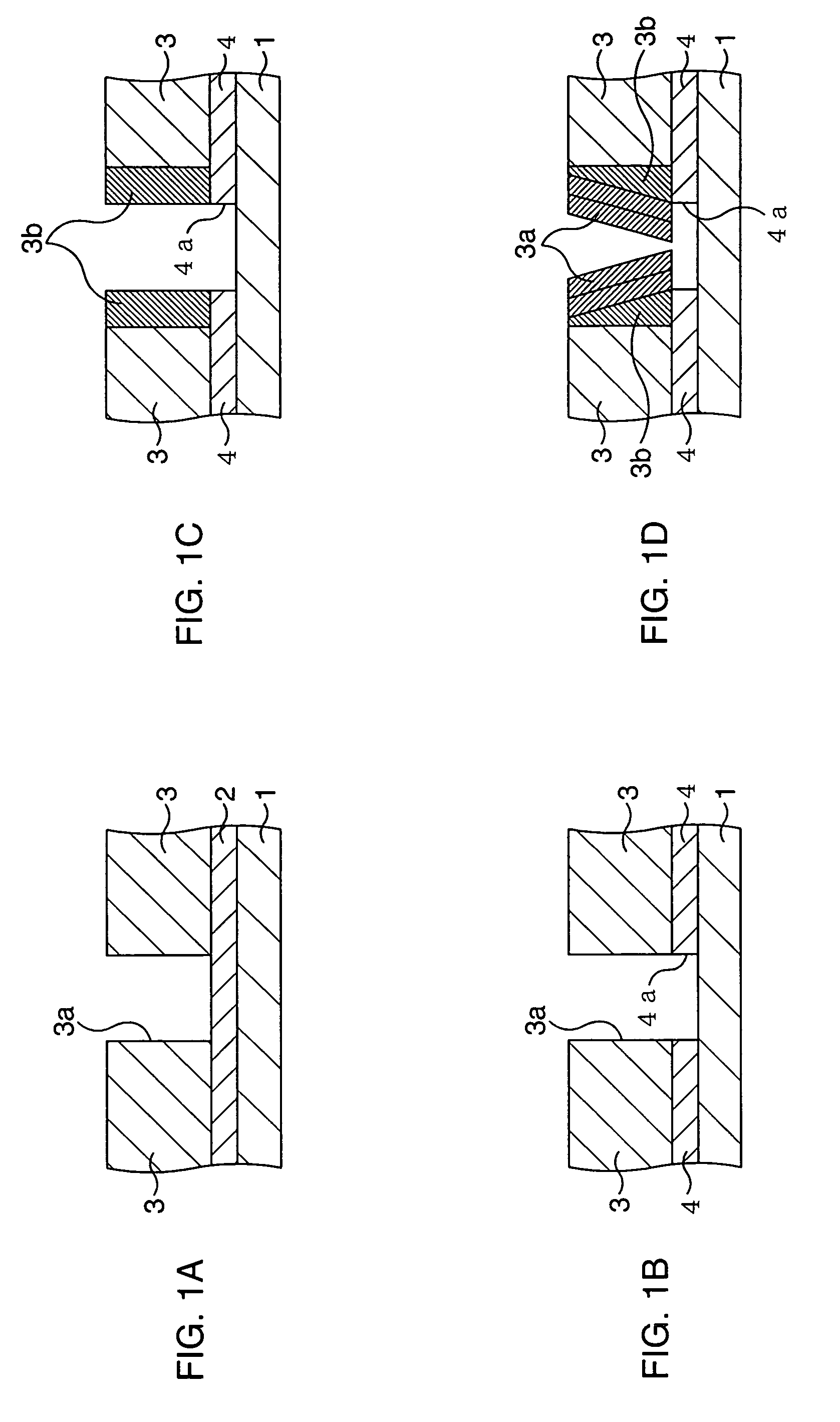Method of processing resist, semiconductor device, and method of producing the same
a technology of semiconductor devices and resists, which is applied in the direction of semiconductor devices, photosensitive material processing, electrical equipment, etc., can solve the problems of reducing the wavelength of light sources to form minute resist apertures, reducing the aperture length, and reducing the cost of equipment and masks. the effect of 0.05 m
- Summary
- Abstract
- Description
- Claims
- Application Information
AI Technical Summary
Benefits of technology
Problems solved by technology
Method used
Image
Examples
embodiment 1
[0047]In this embodiment, the present invention is applied in forming minute contact holes in an interlayer insulator film to manufacture transistors.
[0048]FIGS. 3A to 3C and FIGS. 4A to 4C are schematic sectional views showing the method of manufacturing a transistor in order of steps according to embodiment 1.
[0049]As shown in FIG. 3A, a gate electrode 12 and a source / drain 13 which is a pair of ohmic electrodes are formed on a semiconductor substrate 11.
[0050]Then polyimide resin is applied to a coating thickness of about 1.0 μm by the spin coat method so as to cover the gate electrode 12 and the source / drain 13, and heat treated to form an interlayer insulator film 14. The interlayer insulator film 14 may be a single-layer film consisting of only polyimide resin or a multilayer film consisting of two or more different materials, such as a film consisting of polyimide resin and a nitride film deposited thereon. A resist (for example, PFI-32A, Sumitomo Chemical Co., Ltd.) is appli...
embodiment 2
[0060]In this embodiment, the present invention is applied in forming what is generally called mushroom type gate electrodes using electron beam lithography to manufacture transistors.
[0061]FIGS. 5A to 5D and FIGS. 6A to 6D are schematic sectional views showing the method of manufacturing a transistor in order of steps according to embodiment 2.
[0062]As shown in FIG. 5A, a buffer layer, an InGaAs channel layer, an AlGaAs electron-supplying layer and a GaAs low-resistance layer are first grown sequentially on a semi-insulating GaAs substrate by the MOCVD method to form a compound semiconductor substrate 21, and an active region is formed by oxygen impregnation to form, for example, the source / drain 22, which is a pair of ohmic electrodes consisting of AuGe / Au with a coating thickness of about 20 nm / 200 nm.
[0063]The low-resistance layers about 0.1 μm wide at both ends of the gate finger in the active region are removed by etching to form a groove 42, and a surface component film 23 co...
modified embodiment
[0077]This is another aspect of embodiment 2. In this embodiment, the present invention is applied in forming what is generally called mushroom type gate electrodes using electron beam lithography to manufacture transistors.
[0078]FIGS. 7A to 7D and FIGS. 8A to 8D are schematic sectional views showing the method of manufacturing a transistor in order of steps according to modified embodiment 2.
[0079]As shown in FIG. 7A, a buffer layer, an InGaAs channel layer, an AlGaAs electron-supplying layer and a GaAs low-resistance layer are first grown sequentially on a semi-insulating GaAs substrate by the MOCVD method to form a compound semiconductor substrate 21, and an active region is formed by oxygen impregnation to form, for example, the source / drain 22, which is a pair of ohmic electrodes consisting of AuGe / Au with a coating thickness of about 20 nm / 200 nm.
[0080]A surface component film 23 consisting of, for example, silicon nitride is formed on the compound semiconductor substrate 21 s...
PUM
| Property | Measurement | Unit |
|---|---|---|
| aperture length | aaaaa | aaaaa |
| aperture length | aaaaa | aaaaa |
| wavelength | aaaaa | aaaaa |
Abstract
Description
Claims
Application Information
 Login to View More
Login to View More - R&D
- Intellectual Property
- Life Sciences
- Materials
- Tech Scout
- Unparalleled Data Quality
- Higher Quality Content
- 60% Fewer Hallucinations
Browse by: Latest US Patents, China's latest patents, Technical Efficacy Thesaurus, Application Domain, Technology Topic, Popular Technical Reports.
© 2025 PatSnap. All rights reserved.Legal|Privacy policy|Modern Slavery Act Transparency Statement|Sitemap|About US| Contact US: help@patsnap.com



